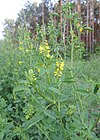Note: This is a project under development. The articles on this wiki are just being initiated and broadly incomplete. You can Help creating new pages.
Melilotus officinalis
Melilotus officinalis, known as yellow sweet clover, yellow melilot, ribbed melilot and common melilot, is a species of legume native to Eurasia and introduced in North America, Africa, and Australia.
Contents
- 1 Uses
- 2 Parts Used
- 3 Chemical Composition
- 4 Common names
- 5 Properties
- 6 Habit
- 7 Identification
- 8 List of Ayurvedic medicine in which the herb is used
- 9 Where to get the saplings
- 10 Mode of Propagation
- 11 How to plant/cultivate
- 12 Commonly seen growing in areas
- 13 Photo Gallery
- 14 References
- 15 External Links
Uses
Poor blood circulation, Leg pain and heaviness, Night cramps, Itchiness, Fluid retention.
Parts Used
Chemical Composition
Twelve compounds were obtained from the 70% ethanol extract of M officinalis and their structures were identified as β-sitosterol, coumarin, methyl 3-(4-hydroxyphenyl)propionate, kaempferol-3-O-α-L-rhamnoside, rutin, apigenin-7-O-β-D-lutinoside, dibutyl phthalate, robinin, clovin, kaempferol-3-O-rutinoside, isoquerecitrin, and medicarpin 3-O-β-glucopyranoside. [1]
Common names
| Language | Common name |
|---|---|
| Kannada | |
| Hindi | |
| Malayalam | |
| Tamil | |
| Telugu | |
| Marathi | NA |
| Gujarathi | NA |
| Punjabi | NA |
| Kashmiri | NA |
| Sanskrit | |
| English | yellow sweet clover, yellow melilot, ribbed melilot, common melilot, |
Properties
Reference: Dravya - Substance, Rasa - Taste, Guna - Qualities, Veerya - Potency, Vipaka - Post-digesion effect, Karma - Pharmacological activity, Prabhava - Therepeutics.
Dravya
Rasa
Guna
Veerya
Vipaka
Karma
Prabhava
Habit
Identification
Leaf
| Kind | Shape | Feature |
|---|---|---|
| Simple | alternate |
Flower
| Type | Size | Color and composition | Stamen | More information |
|---|---|---|---|---|
| Bisexual | 10-20 mm long | White |
Fruit
| Type | Size | Mass | Appearance | Seeds | More information |
|---|---|---|---|---|---|
| Simple Fruit | fgfg | {{{5}}} | {{{6}}} |
Other features
List of Ayurvedic medicine in which the herb is used
Where to get the saplings
Mode of Propagation
How to plant/cultivate
Commonly seen growing in areas
Lowland forest, Coastal forests.
Photo Gallery
References
External Links
- Ayurvedic Herbs known to be helpful to treat Poor blood circulation
- Ayurvedic Herbs known to be helpful to treat Leg pain and heaviness
- Ayurvedic Herbs known to be helpful to treat Night cramps
- Ayurvedic Herbs known to be helpful to treat Itchiness
- Ayurvedic Herbs known to be helpful to treat Fluid retention
- Herbs with Sweet clover used in medicine
- Herbs with common name in English
- Habit - Herbs
- Index of Plants which can be propagated by Seeds
- Herbs that are commonly seen in the region of Lowland forest
- Herbs that are commonly seen in the region of Coastal forests
- Herbs




